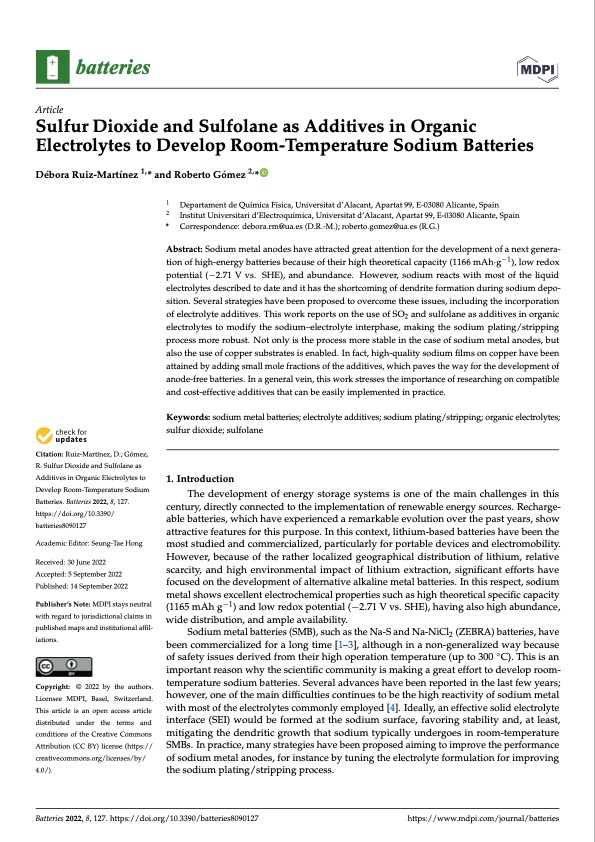
PDF Publication Title:
Text from PDF Page: 001
batteries Article Sulfur Dioxide and Sulfolane as Additives in Organic Electrolytes to Develop Room-Temperature Sodium Batteries Débora Ruiz-Martínez 1,* and Roberto Gómez 2,* 1 2 Abstract: Sodium metal anodes have attracted great attention for the development of a next genera- tion of high-energy batteries because of their high theoretical capacity (1166 mAh·g−1), low redox potential (−2.71 V vs. SHE), and abundance. However, sodium reacts with most of the liquid electrolytes described to date and it has the shortcoming of dendrite formation during sodium depo- sition. Several strategies have been proposed to overcome these issues, including the incorporation of electrolyte additives. This work reports on the use of SO2 and sulfolane as additives in organic electrolytes to modify the sodium–electrolyte interphase, making the sodium plating/stripping process more robust. Not only is the process more stable in the case of sodium metal anodes, but also the use of copper substrates is enabled. In fact, high-quality sodium films on copper have been attained by adding small mole fractions of the additives, which paves the way for the development of anode-free batteries. In a general vein, this work stresses the importance of researching on compatible and cost-effective additives that can be easily implemented in practice. Keywords: sodium metal batteries; electrolyte additives; sodium plating/stripping; organic electrolytes; sulfur dioxide; sulfolane 1. Introduction The development of energy storage systems is one of the main challenges in this century, directly connected to the implementation of renewable energy sources. Recharge- able batteries, which have experienced a remarkable evolution over the past years, show attractive features for this purpose. In this context, lithium-based batteries have been the most studied and commercialized, particularly for portable devices and electromobility. However, because of the rather localized geographical distribution of lithium, relative scarcity, and high environmental impact of lithium extraction, significant efforts have focused on the development of alternative alkaline metal batteries. In this respect, sodium metal shows excellent electrochemical properties such as high theoretical specific capacity (1165 mAh g−1) and low redox potential (−2.71 V vs. SHE), having also high abundance, wide distribution, and ample availability. Sodium metal batteries (SMB), such as the Na-S and Na-NiCl2 (ZEBRA) batteries, have been commercialized for a long time [1–3], although in a non-generalized way because of safety issues derived from their high operation temperature (up to 300 ◦C). This is an important reason why the scientific community is making a great effort to develop room- temperature sodium batteries. Several advances have been reported in the last few years; however, one of the main difficulties continues to be the high reactivity of sodium metal with most of the electrolytes commonly employed [4]. Ideally, an effective solid electrolyte interface (SEI) would be formed at the sodium surface, favoring stability and, at least, mitigating the dendritic growth that sodium typically undergoes in room-temperature SMBs. In practice, many strategies have been proposed aiming to improve the performance of sodium metal anodes, for instance by tuning the electrolyte formulation for improving the sodium plating/stripping process. Departament de Química Física, Universitat d’Alacant, Apartat 99, E-03080 Alicante, Spain Institut Universitari d’Electroquímica, Universitat d’Alacant, Apartat 99, E-03080 Alicante, Spain * Correspondence: debora.rm@ua.es (D.R.-M.); roberto.gomez@ua.es (R.G.) Citation: Ruiz-Martínez, D.; Gómez, R. Sulfur Dioxide and Sulfolane as Additives in Organic Electrolytes to Develop Room-Temperature Sodium Batteries. Batteries 2022, 8, 127. https://doi.org/10.3390/ batteries8090127 Academic Editor: Seung-Tae Hong Received: 30 June 2022 Accepted: 5 September 2022 Published: 14 September 2022 Publisher’s Note: MDPI stays neutral with regard to jurisdictional claims in published maps and institutional affil- iations. Copyright: © 2022 by the authors. Licensee MDPI, Basel, Switzerland. This article is an open access article distributed under the terms and conditions of the Creative Commons Attribution (CC BY) license (https:// creativecommons.org/licenses/by/ 4.0/). Batteries 2022, 8, 127. https://doi.org/10.3390/batteries8090127 https://www.mdpi.com/journal/batteriesPDF Image | Sulfur Dioxide and Sulfolane Sodium Batteries

PDF Search Title:
Sulfur Dioxide and Sulfolane Sodium BatteriesOriginal File Name Searched:
batteries-08-00127-v2.pdfDIY PDF Search: Google It | Yahoo | Bing
Salgenx Redox Flow Battery Technology: Salt water flow battery technology with low cost and great energy density that can be used for power storage and thermal storage. Let us de-risk your production using our license. Our aqueous flow battery is less cost than Tesla Megapack and available faster. Redox flow battery. No membrane needed like with Vanadium, or Bromine. Salgenx flow battery
| CONTACT TEL: 608-238-6001 Email: greg@salgenx.com | RSS | AMP |